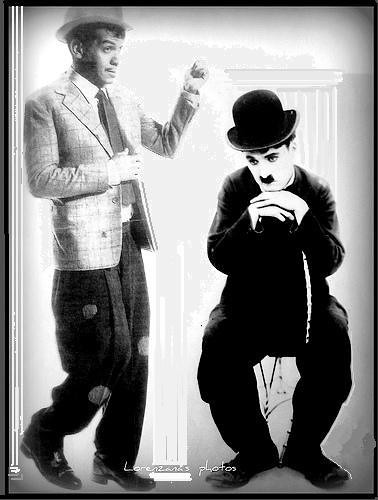PLAZA CLASSIC FILM FESTIVAL DAY FOUR OVERVIEW
On this day, again I go to just two films: a foreign-language picture and a documentary. Similarly, like when I saw 12 Angry Men and The Women, I find that these two films, both in the smaller Philanthropy Theater, share a theme: both involve comedic geniuses, who admired the other and recognized the talent the other possessed.
And as a side note, they do have distinctive mustaches.
The first film, El Bolero de Raquel, was the first color film by "Mexico's Charlie Chaplin", Mario Moreno 'Cantinflas' (pronounced cahn-TEEN-flas). The second, Charlie: The Life and Art of Charles Chaplin, was a documentary about the English-language Cantinflas.
We see in El Bolero de Raquel that Chaplin was a powerful influence on Cantinflas. Both were basically 'tramps', poor men who did the best they could despite the world going out of its way to put them down. In Cantiflas' wardrobe, with the baggy pants (complete with patches) and in his body movements, we see that Cantinflas could be the Little Tramp's Mexican cousin. They also had a great sentimentality beneath the clowning, an appeal to the heart. El Bolero de Raquel, where Cantinflas is asked to care for a child, is itself a spiritual descendant of Chaplin's The Kid (which was also featured in the PCFF).
However, the great difference between Chaplin and Cantinflas was that the latter's primary skills were verbal, while the former's was visual. This isn't to say that Chaplin couldn't speak or Cantinflas couldn't move. In truth, though, Cantinflas is at his best when he speaks, befuddling the people around him until what at first is a straightforward situation becomes so convoluted that even Cantinflas ends up confused by what is going on. He usually would do this to trick his opponents and get out of situations, and always succeeding.
Chaplin's great strength, conversely, was in the visuals jokes. The Little Tramp, let's remember, never spoke. If you want to use The Great Dictator as a 'yes, he did', it should be remembered that Chaplin didn't play the Tramp but a Tramp-like character. Chaplin was a near-total visual artist. When we think of his iconic moments, they are always in silent films: his "Bread Rolls Dance" in The Gold Rush, repairing the machinery in Modern Times, the heartbreaking ending of City Lights.
I don't think people connect Chaplin's genius with verbal dexterity or Cantinflas' genius with physical prowess. They both could do it because their genius knew only the limits of their own creativity, but they both had specific skills that suited them better.
Perhaps this is why Cantinflas has not fully earned his place in comedic circles outside Spanish-speaking territories. The language which Cantinflas used so well was also the greatest limitation to a career outside Latin America. With the exception of Around the World in 80 Days, where uber-producer Mike Todd managed to pull off one feat after another (among them, passing a Mexican off as the Frenchman Passepartout), Cantinflas made no forays in non-Spanish films apart from Pepe, but that's really a film that even the biggest Cantinflas fan will say was a mistake.
As another side note, what makes Around the World in 80 Days an extraordinary picture is that while Cantinflas may be (improbably) playing a Frenchman and gets second-billing, in Latin America the film was seen as a 'Cantinflas' film because his character might have been named 'Passepartout', but he was essentially playing 'Cantinflas'. Therefore, if you've never had the chance to see a Cantinflas film, watching Around the World in 80 Days is as close to one that English-speakers will get.
Truth be told, I remember when my mother would take my grandmother and myself to see Mexican movies at the Plaza. I would watch films with Mario Almada, Maria Elena Velasco "La India Maria", Vicente Fernandez, and of course, Cantinflas. I never thought I'd see at least one of them at the Plaza all these years later, and Cantinflas, it's nice to have you back where you belong.
It's a credit to both that they recognized the other's extraordinary talent. Charlie Chaplin commented that Mario Moreno Cantinflas was the greatest living comedian. High praise from a Giant among Comedic Geniuses. Cantinflas, for his part, took much from Chaplin's downtrodden Little Tramp to create his own unique character.
Genius Squared.
 |
| Mario Moreno 'Cantinflas': 1911-1993 Charles Chaplin: 1899-1977 |


No comments:
Post a Comment
Views are always welcome, but I would ask that no vulgarity be used. Any posts that contain foul language or are bigoted in any way will not be posted.
Thank you.